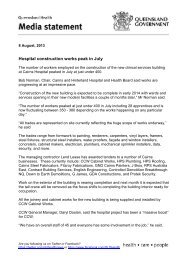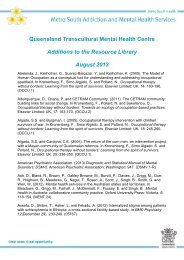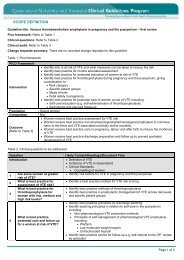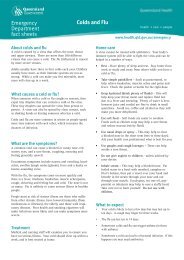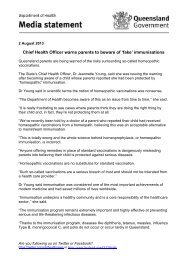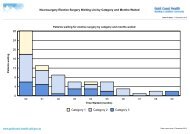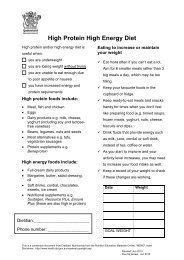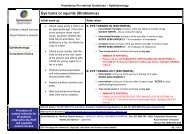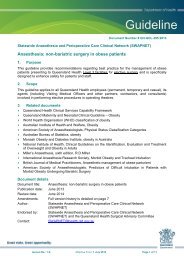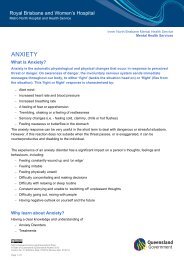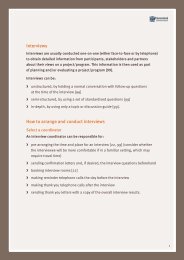Torture and trauma - Queensland Health
Torture and trauma - Queensland Health
Torture and trauma - Queensland Health
Create successful ePaper yourself
Turn your PDF publications into a flip-book with our unique Google optimized e-Paper software.
&<br />
Introduction<br />
S<br />
urvivors of torture come into Australia<br />
from a wide number of countries. These<br />
includes places as widespread as Afghanistan,<br />
Burma, the Former Yugoslavia, Vietnam, East<br />
Timor, El Salvador, Chile, Iraq, Iran <strong>and</strong> the<br />
countries of the Horn of Africa.<br />
An estimated 70% of refugees coming into<br />
Australia each year have suffered some form<br />
of torture or <strong>trauma</strong>. They are often seen by<br />
health care professionals, because of pressing<br />
medical problems <strong>and</strong> because they present<br />
with somatic symptoms which camouflage<br />
mental conditions.<br />
The most common physical <strong>and</strong> psychological<br />
sequelae of the experience of torture <strong>and</strong><br />
<strong>trauma</strong> are:<br />
o Pains, headaches, tremors, weakness,<br />
sweating, fainting.<br />
o Difficulty in concentrating.<br />
o Deafness, visual disturbances.<br />
o Insomnia, nightmares, panic attacks.<br />
o Intrusive memories, nervousness.<br />
o Feelings of powerlessness, worthlessness,<br />
irritability.<br />
o Feelings of aggressiveness.<br />
o Sexual disturbances.<br />
o F e e l i ngs of alie na t ion, de p re s s ion <strong>and</strong> guilt.<br />
Many refugees in Australia will not have been<br />
tortured, but the physical <strong>and</strong> psychological<br />
stress under which they have been placed in<br />
the course of the journey from “home” to<br />
Australia may result in the manifestation of<br />
similar problems. Almost all will have<br />
experienced dislocation from families <strong>and</strong><br />
some will have experienced:<br />
o Being attacked by pirates<br />
o Being raped or observing others being<br />
raped<br />
o Being physically assaulted<br />
o Existing in a state of fear for long periods<br />
of time.<br />
Methods of <strong>Torture</strong><br />
Not all torture is physical <strong>and</strong> not all<br />
physical torture results in visible<br />
damage. The sophistication of torture<br />
methods is increasing <strong>and</strong> many of these<br />
result in soft tissue damage without<br />
permanent scarring.<br />
Physical methods of torture include:<br />
o Forced st<strong>and</strong>ing.<br />
o Submersion in cold water.<br />
o Starvation.<br />
o Rape <strong>and</strong> sexual molestation.<br />
o Electric shocks.<br />
o Burning with fire.<br />
P<br />
7
ge<br />
2<br />
o Dismemberment.<br />
o Beatings.<br />
Indicators of Trauma<br />
Useful diagnostic indicators of torture<br />
<strong>and</strong> <strong>trauma</strong> are (a) that the person<br />
has migrated from a country where torture<br />
is used, <strong>and</strong> (b) they have some of the<br />
physical <strong>and</strong>/or psychological signs of<br />
torture <strong>and</strong> <strong>trauma</strong>.<br />
A person who is a survivor of torture <strong>and</strong><br />
<strong>trauma</strong> may be clinically depressed. If a<br />
person comes to see you in your<br />
professional capacity, whether they are a<br />
survivor of torture <strong>and</strong> <strong>trauma</strong> may be<br />
irrelevant to your care. However, if their<br />
reason for seeking help, or the treatment<br />
they require, means that they will need to<br />
discuss their history of <strong>trauma</strong>, you will<br />
need to be aware of a number of issues.<br />
The Loss of Trust<br />
The single greatest issue affecting<br />
the healthy integration of survivors<br />
of torture into the community is their loss<br />
of trust.<br />
<strong>Torture</strong>rs may have been public servants<br />
who were just “doing their job”. Some of<br />
these people would have been doctors,<br />
de nt i s t s, nu r s e s, or other health prof e s s io na l s.<br />
Prior to being tortured, many survivors<br />
would have listened to, trusted, <strong>and</strong><br />
respected people from these professions.<br />
In some regions there was no easy way of<br />
deciding to which “side” a person belonged.<br />
This profoundly affects survivors’ ability to<br />
trust others, even when they have left<br />
that country.<br />
Establishing Trust<br />
o Keep in mind that it may not be<br />
necessary to know the detailed history<br />
of torture of a patient.<br />
o What a non-<strong>trauma</strong>tised patient may<br />
consider a brusque professional manner<br />
may be more reminiscent of<br />
interrogation for a survivor of torture.<br />
o The power relationship between the<br />
patient <strong>and</strong> the health professional must<br />
be h<strong>and</strong>led with sensitivity, <strong>and</strong> should<br />
include constant attempts to emphasise<br />
the client's autonomy.<br />
o Even the most innocuous of treatments<br />
may trigger a <strong>trauma</strong>tic response<br />
because of some association with a past<br />
incident of torture.<br />
Specific examinations can also add to the<br />
<strong>trauma</strong> experience. Gynaecological<br />
examinations, for example, may be difficult<br />
for women who have been raped or<br />
molested. Similarly, patients undergoing<br />
dental treatment may feel very anxious, if<br />
they have been tortured by someone who<br />
pulled their teeth out using dental<br />
instruments. EEG <strong>and</strong> ECG leads may bring<br />
back memories of electrocution.<br />
o Try to explain the use of instruments<br />
prior to performing a procedure.<br />
o The patient needs to know what is going<br />
to happen <strong>and</strong> why it must be done.<br />
o Most important is the need to seek the<br />
full consent of the patient to proceed<br />
with an examination or treatment. Be<br />
prepared to defer it if the patient cannot<br />
yet tolerate it.
Post-Traumatic<br />
Stress Disorder &<br />
Chronic Pain<br />
Two common clinical problems for<br />
survivors of torture <strong>and</strong> <strong>trauma</strong> are<br />
Post Traumatic Stress Disorder (PTSD) <strong>and</strong><br />
Chronic Pain Syndrome (CPS).<br />
Post Traumatic Stress isorder<br />
PTSD is a psychological reaction to an<br />
uncommon <strong>and</strong> extremely stressful event,<br />
which is of sufficient severity to have<br />
caused a reaction in most people. In other<br />
words, it can be regarded as a normal<br />
reaction to an abnormal situation.<br />
Many survivors of torture suffer from the<br />
debilitating effects of PTSD. They may be<br />
unable to moderate anger <strong>and</strong> irritability.<br />
They are often unemployed <strong>and</strong> socially<br />
isolated, <strong>and</strong> family members may be a<br />
readily available target for their anger.<br />
Chronic Pain Syndrome<br />
If the continuation of pain following torture<br />
is not diagnosed <strong>and</strong> treated, a “chronic<br />
pain cycle” is likely to develop.<br />
Because torturers frequently aim to inflict<br />
maximum pain <strong>and</strong> injury, but minimise the<br />
physical evidence of injury, torture is often<br />
directed toward the soft tissues (muscles,<br />
joint capsules, <strong>and</strong> ligaments). Signs of<br />
physical damage may not be obvious in the<br />
long term. Electrical torture, for example, is<br />
virtually undetectable just days after<br />
torture, but it can cause extensive internal<br />
da ma ge <strong>and</strong> bleeding into muscles <strong>and</strong> joint s.<br />
Interpreters<br />
If you find yourself treating a patient<br />
who is a possible or confirmed<br />
survivor of torture, there may be language<br />
problems. The rule in this situation is to be<br />
guided by the wishes of the patient. Using<br />
family members or someone else who<br />
happens to underst<strong>and</strong> the patient's native<br />
language as a translator is inadvisable.<br />
Some patients readily use an interpreter.<br />
Others will use an interpreter if they come<br />
from another country – for example, a<br />
Chilean acting as an interpreter for someone<br />
from El Salvador.<br />
Using a telephone interpreter is another<br />
option which increases the sense of<br />
anonymity for the patient. Other patients<br />
will be reluctant to use any interpreter <strong>and</strong><br />
will prefer to struggle with imperfect<br />
English. Either way, it should be the<br />
patient’s choice.<br />
Resources<br />
Queensl<strong>and</strong> Program of Assistance to<br />
Survivors of <strong>Torture</strong> <strong>and</strong> Trauma (QPASTT)<br />
Tel: (07) 3844 3440<br />
Translating <strong>and</strong> Interpreting Service (TIS)<br />
Tel: 131450<br />
Acknowledgments<br />
This profile was developed by<br />
Pascale Allotey, Lenore M<strong>and</strong>erson,<br />
Jane Nikles, Daniel Reidpath <strong>and</strong> Jo<br />
Sauvarin at the Australian Centre for<br />
International <strong>and</strong> Tropical <strong>Health</strong>, <strong>and</strong> Pat<br />
Roche of the Department of Physiotherapy<br />
at The University of Queensl<strong>and</strong>, on behalf<br />
of Queensl<strong>and</strong> <strong>Health</strong>. It was developed<br />
with the assistance of community groups<br />
<strong>and</strong> health care providers. This is a slightly<br />
condensed form of the full profile which<br />
may be found on the Queensl<strong>and</strong> <strong>Health</strong><br />
INTRANET - QHiN http://qhin.health.<br />
qld.gov.au/hssb/hou/hom.htm <strong>and</strong> the<br />
Queensl<strong>and</strong> <strong>Health</strong> INTERNET http://qhin.<br />
health.qld.gov.au/ hssb/hou/hom.htm.<br />
P<br />
7
ge<br />
4<br />
Material for this profile was drawn from a<br />
number of sources including various<br />
scholarly publications. In addition, Culture<br />
& <strong>Health</strong> Care (1996), a manual prepared by<br />
the Multicultural Access Unit of the <strong>Health</strong><br />
Department of Western Australia, was<br />
particularly useful.



